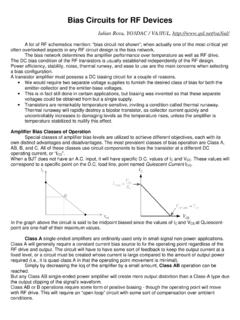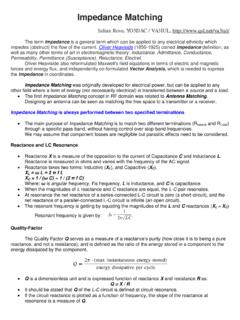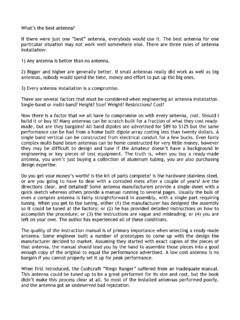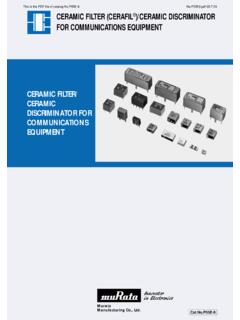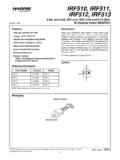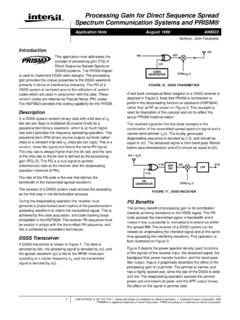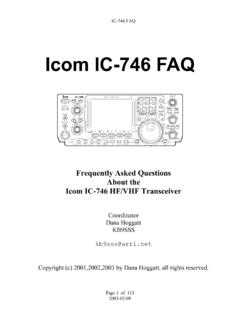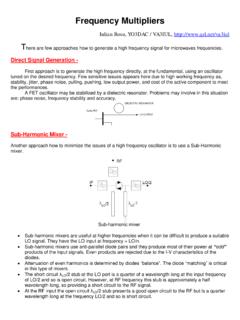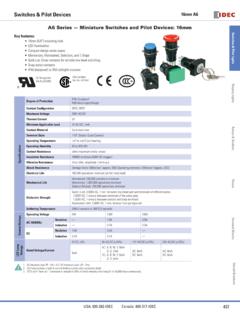Transcription of RF Switches - QSL.net
1 RF Switches Iulian Rosu, YO3 DAC / VA3 IUL, In the transmission path, RF Switches can efficiently convey paths. Four basic electrical parameters can be used to describe the function of this sort of RF. switch. Despite the fact that numerous parameters affect the performance of RF Switches , the following four are crucial due to their significant correlation: 1. Isolation Isolation is an index that measures the effectiveness of the RF switch cut-off by attenuating the signal between the input and output of the circuit. 2. Insertion loss When the RF switch is turned ON, insertion loss (also known as transmission loss).
2 Is the total power loss. Because insertion loss can immediately contribute in system noise figure, it is the most important metric for the RF designers. 3. Switching time The time it takes for the RF switch to convert from ON state to the OFF state, and vice versa is referred to as switching time. For high-power switching, this time can be measured in microseconds, and for low-power high-speed switching, it can be measured in nanoseconds. The most typical definition of switching time is the amount of time it takes for the input control voltage to go from 50% to 90% of its ultimate power.
3 4. Power handling capacity The power handling capability of a switch is defined as the maximum RF input power that the switch can withstand without deteriorating its electrical performance permanently. Electromechanical RF Switches First RF Switches that were used in wireless applications were mechanical Switches (keys, aerial Switches , and electro-mechanical relays). Those mechanical or electro-mechanical Switches generally switch DC and low frequencies, and relative high voltage and currents. They require having good electrical contacts and to use high isolation materials.
4 There are two types of electromechanical RF Switches : terminated and non- terminated. When all ports of an RF switch are terminated with a 50 ohms load , the selected port is closed, cutting off or isolating all currents. The incident signal energy will be absorbed by the termination resistor and will not be reflected back, to the RF source in this way. In a non-terminated RF switch, the system must accomplish external impedance matching to reduce energy reflection. The non-terminated RF switch has the advantage of having a low insertion loss. Electro-mechanical (EM) RF Switches provides: - low insertion loss (< ).
5 - high isolation (>100dB). - high power handling - no video leakage - very high ESD immunity - their frequency range starts from DC. Electro-mechanical RF Switches have lower operating lifetime than Solid-State Switches . The operating life of an electro-mechanical switch can be defined as the number of cycles the switch will complete while meeting all the RF and repeatability specifications. The operating life refers to the electrical life and RF properties of the switch, and not to the mechanical life (which is much longer than the electrical life).
6 There are some high-quality coaxial relays that use electro-mechanical Switches referred as frictionless switching (since there is no friction produced between the jumper contact and center conductor), and this configuration produces Switches that can mechanically actuate for tens of millions of cycles. The drawback is, they might not fail mechanical, but their insertion loss gets higher due to increasing in time the resistance of the contacts. Solid-State RF Switches Solid-State RF Switches have smaller package thickness and physical dimension than Electromechanical RF Switches since their circuit assembly is relatively flat and does not contain big components.
7 High speed silicon PIN diodes or Field-Effect Transistors (FET), or integrated silicon or FET monolithic microwave integrate circuits, are switching elements used in solid-state RF Switches . Other chip components like capacitors, inductors, and resistors are independently integrated on the same circuit board as these switching parts. PIN diode-based Switches have higher power handling capabilities, but FET-based switch devices have faster switching speeds. Solid-state Switches , have an infinite service life since they do not contain moving parts. The solid-state RF switch has high isolation (60>80dB), a quick switching speed (100 nanoseconds), and is stress and vibration resistant.
8 In terms of insertion loss, solid-state RF Switches are inferior of electromechanical Switches . Solid-state RF Switches have limits in low-frequency applications, the lowest limit of its operating frequency is merely kilohertz, not DC, due to the semiconductor diode's inherent carrier lifetime characteristics. Solid-state RF Switches are also more susceptible to electrostatic discharge, and their power handling capabilities are influenced by the connector type, operating frequency, and ambient temperature. Certain PIN diode RF switch topologies can withstand peak power of several kilowatts, but this comes to the cost of slower switching rates.
9 There are two types of solid-state RF Switches : absorptive and reflecting. In order to obtain a lower voltage standing wave ratio (VSWR) in both ON and OFF. states, the absorption switch has a 50-ohm terminal matching resistance at each output port, which can absorb the incident signal energy, but the port that is not linked to the terminating matching resistor will reflect it. Absorptive Switches are ideal for applications where the RF source's echo reflection must be minimized. The reflecting RF switch does not have a terminal resistor to reduce the insertion loss of the open port, and is ideal for applications where reflections does not affect the system performance.
10 Emerging micro-electromechanical systems (MEMS) switch technology attempts to deliver the advantages of traditional electro-mechanical Switches , but in a small form factor. MEMS Switches employ micro-miniaturized mechanical contacts controlled by electrostatic forces to make RF connections. Types and Architectures of Solid-State RF Switches There are few main types of Solid-State RF Switches : High-Speed Silicon diodes RF Switches PIN diodes RF Switches Field Effect Transistors (FET) RF Switches Hybrid (FET and PIN diode) RF Switches Two basic switch architectures that describe the behavior of the unused switch port are classified as Absorptive or Reflective.
